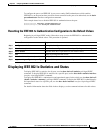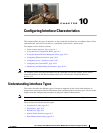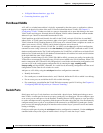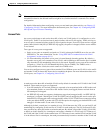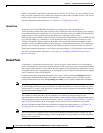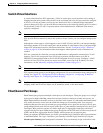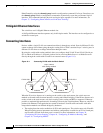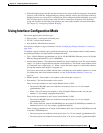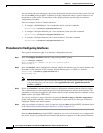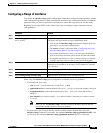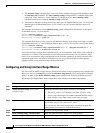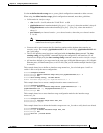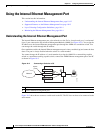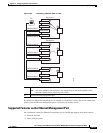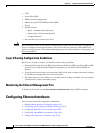
10-7
Cisco Catalyst Switch Module 3110 and 3012 for IBM BladeCenter Software Configuration Guide
OL-12189-01
Chapter 10 Configuring Interface Characteristics
Using Interface Configuration Mode
• Fallback bridging forwards traffic that the switch does not route or traffic belonging to a nonroutable
protocol, such as DECnet. Fallback bridging connects multiple VLANs into one bridge domain by
bridging between two or more SVIs or routed ports. When configuring fallback bridging, you assign
SVIs or routed ports to bridge groups with each SVI or routed port assigned to only one bridge
group. All interfaces in the same group belong to the same bridge domain. For more information,
see Chapter 46, “Configuring Fallback Bridging.”
Using Interface Configuration Mode
The switch supports these interface types:
• Physical ports—switch ports and routed ports
• VLANs—switch virtual interfaces
• Port channels—EtherChannel interfaces
You can also configure a range of interfaces (see the “Configuring a Range of Interfaces” section on
page 10-9).
To configure a physical interface (port), specify the interface type, stack member number, module number,
and switch port number, and enter interface configuration mode.
• Type—Gigabit Ethernet (gigabitethernet or gi) for 10/100/1000 Mb/s Ethernet ports or 10-Gigabit
Ethernet (tengigabitethernet or te) for 10,000 Mb/s.
• Stack member number—The number that identifies the switch within the stack. The switch number
range is 1 to 9 and is assigned the first time the switch initializes. The default switch number, before
it is integrated into a switch stack, is 1. When a switch has been assigned a stack member number,
it keeps that number until another is assigned to it.
You can use the switch port LEDs in Stack mode to identify the stack member number of a switch.
For information about stack member numbers, see the “Stack Member Numbers” section on
page 5-8.
• Module number—The module or slot number on the switch that is always 0.
• Port number—The interface number on the switch.
These are the port numbers on the Catalyst Module Switch 3110X:
–
The internal 1000 Mb/s ports are numbered consecutively from 1 to 14; for example,
gigabitethernet 1/0/1.
–
When a Cisco X2 transceiver module is in the 10-Gigabit Ethernet module slot, the port
numberis 1; for example, tengigabitethernet1/0/1.
These are the port numbers on the Catalyst Switch Module 3110G:
–
The internal 1000 Mb/s ports are numbered consecutively from 1 to 14; for example,
gigabitethernet 1/0/1.
–
On a switch with four external 10/100/1000 ports, the external 10/100/1000 port numbers are
numbered from 15 to 18; for example, gigabitethernet1/0/16.
These are the port numbers on a Catalyst Switch Module 3012 with 12 internal 1000 Mb/s ports and
4 external 10/100/1000 ports:
–
The internal ports are numbered consecutively from 1 to 12; for example, gigabitethernet 0/3.
–
The external ports are numbered consecutively from 13 to 16; for example, gigabitethernet0/15.



